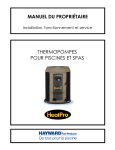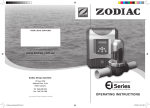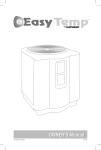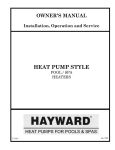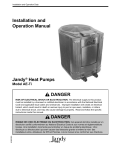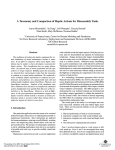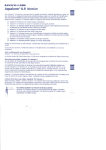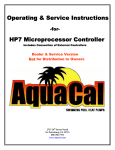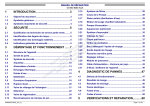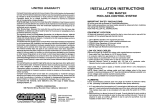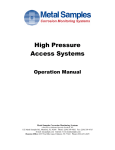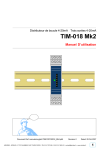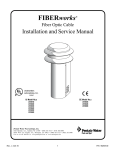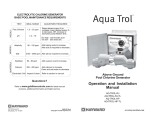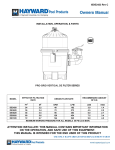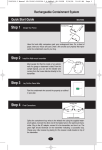Download Heat Pump Style Pool/Spa Heaters
Transcript
OWNER’S MANUAL Installation, Operation and Service HEAT PUMP STYLE POOL / SPA HEATERS HP13023616 Rev E October 2007 Owner’s Manual I. Operating Principles • • • II. How a heat pump works…………...………………………………………………….2 Get familiar with your heat pump ………………………………………………...….3 Temperature control systems for each model……………………….………...……4-7 Installation Specifications and Procedures • • III. Application Guidelines and Maintenance • • • • • • • IV. Receipt inspection of unit……………………………………………………...……8 Determining optimum location…………………………………………………..….8 o Clearance…………………………………………………………….………..….9 o Placement………………………………………………………………………....9 o Drainage…………………………………………………………………………..9 o Other Precautions………………………………………………………………..10 Climate Conditions……………………………………………………...……….…..10 Pool Cleaning Systems………………………………………………………………10 Efficient Practices o Using a pool cover…………………………………………..…………………..11 o Water flow………………………………………………………………………11 o Chlorine content…………………………………………………………………11 At the beginning of each season………………………………………….………….12 Occasional / Weekend Use…………………………………………….…………….13 Summertime Shutdown…………………………………………….………………..13 At the end of each season………………………………………...………………….13 Service Procedures • • Before you call for service……………………………………………..………..14, 36 Troubleshooting guide…………………………………………………………...15-16 V. Warranty……….……………………..……………………………….………...17 VI. Installation Guide……………………………………………………...…18-36 HP13023616 Rev E How a Heat Pump Works Hayward Heat Pumps take heat from the environment and use it to heat your pool water. During heat pump operation, high pressure liquid Refrigerant at liquid line (A) is throttled by a restriction valve (usually a TXV) and turned into low pressure liquid and vapor two phase flow. The two-phase refrigerant flows through evaporator, where the liquid phase evaporates into vapor by absorbing heat from the surrounding air (B). At the outlet of the evaporator, it becomes a low pressure vapor flow. The compressor (C) receives this flow and compresses it to a high pressure and high pressure vapor flow. The heat carried by the flow is then released to surrounding water from the pool through the heat exchanger (D). At the same time, the high pressure refrigerant vapor is then condensed back into high pressure liquid in liquid line (A), which completes the cycle. The water (F), which is being forced through the heat exchanger (D) by the pool pump, is heated by three to five degrees as it passes through and returned to the pool as heated water. (G) This process can also be reversed to remove heat from pool water. 2 Heat Pump Pool / Spa Heater Owner’s Manual Get Familiar with Your Heat Pump Safety Features Hayward heat pumps are equipped with safeguards that will stop operation to protect your unit in case of the following events: • Excessively high refrigerant pressure • Excessively high water temperature • Loss of refrigerant • Fan Motor Failure • Evaporator Freeze-up • Low Ambient Temperature High / Low Refrigerant Pressure Switches • The high-pressure switch senses the refrigerant pressure in the sealed refrigeration system and shuts the heater down in the event unsafe operating pressures are reached. The heat pump will automatically reset after the system pressure drops back to normal operating pressures. When this switch is tripped, digital displays will read “HI” • The low-pressure switch senses the refrigerant pressure in the sealed refrigeration system to protect against certain conditions that could be detrimental to compressor life. The switch shuts the unit down in the event of loss of refrigerant, fan motor failure, evaporator freeze-up and airflow blockage. The switch automatically resets when the pressure rises to normal operating pressures. The display will show “LP” if this switch is tripped. Evaporator Freezing The low-pressure switch will shut the heat pump down when the evaporator starts to freeze. When the unit starts to freeze the low-pressure switch will be tripped, causing the display to read “LP” This will prevent the evaporator from becoming damaged or deformed. Water Pressure Switch The water pressure switch contacts close when pressure is applied as pool water flows through the heat exchanger. Low flow rates as well as no flow will let these contacts open and this will cause the unit to shut down. The display will read “PS” if the water pressure is not sufficient. Time Delay All models use a 5-minute time delay to prevent repeated tripping of the compressor thermal overload, which is caused by attempting startup before system pressures are equalized. Any interruptions, outside of power loss, will result in a 5-minute time delay. Low Ambient Temperature If the air outside the heat pump is not warm enough to produce heat, the system will shut down. The actual point at which your unit will shut down due to low temperature varies depending on which model you purchased, current weather conditions, and the amount of sunlight reaching the heat pump. The shutdown can occur anywhere within a wide range of temperatures, usually 45°F55°F. This is not a “fixed” range. We stress that climate conditions, sunlight, and various models respond quite differently to low ambient temperature. A shutdown occurs because low temperatures will activate the systems low-pressure safeguard switch (digital thermostats will display a code “LP”.) The unit will start up again when the temperature has raised enough to reset this switch. Note: Low ambient temperature does not necessarily affect the Chiller models or the cooling cycle of the heat/cool units. 3 Analog Thermostat (HPABG) Power Indicator Light: Shows that proper power is supplied. Heater Indicator Light: Shows the unit is operating normally and the thermostat is making a demand for heat. Approx. 83°F Temperature Control Knob: Adjust knob to desired range, using the diagram on the left as a guide. The thermostat has a temperature range from 60°F – 104°F(approx. ± 5° at the mid point.) Once you have the dial is set to the preferred temperature, the unit will achieve and maintain this temperature. 104°F AUTO For help with this type of control, refer to the troubleshooting guide. (pg. 15-16) 60°F Single Mechanical Thermostat Approx. 83°F RUN 60°F AUTO HOT 104°F Run Indicator Light: Shows the unit is operating normally and the thermostat is making a demand for heat. Temperature Control Knob: Adjust knob to desired range, using the diagram above as a guide. The thermostat has a temperature range from 60°F – 104°F. Once the dial is set to a preferred temperature, the unit will achieve and maintain this temperature. ** The Single Mechanical Thermostat models do not turn off under 60 degrees F. This model was designed to come on automatically if your water temperature is below 60 degrees to prevent the pool from becoming excessively cool and creating long recovery times. If your application dictates the need to turn the heater off for extended periods of time, use the circuit breaker. For help with this type of control, refer to Troubleshooting Guide for MECHANICAL Thermostat Control in the back of the owner’s manual. 4 Heat Pump Pool / Spa Heater Owner’s Manual HPC-1 (For models HP6002, HPABGDELUXE2, PE42B2S2, HP21002, HP21002C and PE52A62) Heating Indicator Light: Display: On/Off: . Shows the unit is operating normally and the thermostat is making a demand for heat. When power is supplied to the unit, the display will either show temperature, diagnostic code (such as “PS”), or rolling dots. This control does not have a true on/off feature. The unit uses standby mode instead. Rolling dots in the display indicate standby. Standby mode serves two functions. (1) It serves as an “off” mode, which keeps the heat pump from transferring heat into your pool water. (2) Standby allows a pool owner with remote controlling systems, such as Goldline, Jandy or Pentair to maintain pool and spa temperatures via their remote. To enter standby mode: If pool mode is active (indicated by the green led over the pool button), press the pool button once. Rolling dots should appear on the display. If spa mode is active (indicated by the green led over the spa button), press the spa button once. Rolling dots should appear on the display. To exit standby mode: Press either the pool or spa mode button. Mode Selection: Selecting the desired mode of operation (spa or pool) is accomplished using the POOL / SPA buttons. A green LED above buttons designates the active mode. When the pool mode is active, any displays or adjustments apply only to the pool mode. Adjustments for spa mode must be made while the spa button is activated. A user can switch between modes without turning the control to standby first. Temperature Setpoint: Pool mode range is 50-104°F (21-40°C). Spa mode range is 50-104°F (21- 40°C). Adjust the setpoint: Continuing to hold the up or down button will scroll the setpoint value until the desired setpoint is reached. When the desired value has been reached, release the button. The new setpoint will flash to indicate a new value has been recognized and the display will revert back to water temperature as indicated by a steady display. Note: The temperature reading displayed when the unit is in operation (run indicator light is present) displays the current water temperature. To display the setpoint: Press and release the Temperature Set up or down button once will display the current setpoint for 3 seconds. For help troubleshooting this type of control, refer to the Troubleshooting Guide for DIGITAL Thermostat Control in the back of this manual. 5 HPC4 (For model HP2100TCO2 and PE52A6TCO2) The HPC-4 temperature control is similar to the HPC- 1 shown on previous page, with one difference. The HPC-4 has a Time Clock Override with a TC OVRD indicator light. Please read the data for the HPC-1 on the previous page before continuing. It will provide you with descriptions of button functions and setpoint programming. Time Clock Override: Notes: 1.An electrician must wire the TCO function to your pool system before it will work. 2.The 2-hour TCO checking interval cannot be adjusted. This feature must be connected by an electrician. TCO provides a method of maintaining the pool temperature when a time clock has the pool filter pump turned off. TCO function then controls the pool filter pump. TCO will automatically turn the pool filter pump on after 2 hours of “off time”. It will run the filter pump for 10 minutes while monitoring the water temperature. If there is more than a 2-degree difference between the setpoint and the actual pool temperature the heat pump will energize and continue to run until the setpoint is satisfied. A user may temporarily override the TCO. An example would be that you want to use your pool between 9:00 and 10:00 pm. The control may be programmed to energize the filter pump, which will engage the heat pump to maintain the pool temperature. This is a temporary measure that can be initiated in 30-minute increments, for a period up to 9.5 hours. Programming for Temporary Pump Override: 1) 2) 3) Push TC OVRD button – Display reads P0.0 Push up (RED) button – display reads P0.5 (Each time the up Arrow engages, the display will increase by .5 increments. Each .5 increment equals 30 minutes, 9.5 hours is the max.). Push down (BLUE) button to decrease the temporary override time. Example of typical TCO cycle: When the time clock turns off the filter pump, a “PS” will show on the display. A timer starts inside the controller. After 2 hours, the heater will start the filter pump to circulate water. “PS” is removed from the display and if a demand for more heat is made, the heater goes back to normal operation. When the water is brought back to temperature, the TCO turns off the filter pump and the heat pump will shut-down, displaying “PS”. The 2-hour timer is reset and the cycle will begin anew. For help troubleshooting this type of control, refer to the Troubleshooting Guide for DIGITAL Thermostat Control in the back of this manual. 6 Heat Pump Pool / Spa Heater Owner’s Manual HPC-5 Heat/Cool (For models HP3100) The HPC-5 is an upgrade of the HPC-4 with the addition of an AUTO function. This allows the heat pump to heat or cool the water automatically to maintain the setpoint. The HPC-5 also has an optional Time Clock Override (TCO-This feature must be connected by an electrician to operate.) Read the instructions for the HPC-1 and HPC-4 fully before continuing. . The HPC-1 page will provide you with descriptions of button functions and setpoint programming. If you have purchased the TCO option, the HPC-4 page will provide TCO functionality and programming procedures. Setting the AUTO function: Setting unit to cool only: Time Clock Override: 1. Disengage the AUTO mode (the AUTO mode indicator light will be off.) 2. Program your desired temperature setpoint. 3. Press the AUTO button to activate the automatic heat / cool function. (AUTO mode indicator will light.) 4. “AC3” should show on the display (set at the factory). “AC” indicates that the cooling function is enabled and the “3”means that when the water temperature is 3°F above the setpoint, the unit will energize to cool your pool or spa. By using the up and down keys, the AC3 can be changed to values ranging from AC3 to AC9. Engage the AUTO mode and use the up button to scroll past “AC9”. You will notice that after the display of “AC9” an “ACP” (AUTO Cool Primary) will be displayed. When “ACP” is displayed, the unit will only cool the pool and will not go into the heating mode, no matter how cool the pool gets. NOTE: The RUN light will flash during cooling cycles. Refer to TCO information on the previous page. (HPC-4) If troubleshooting this controller, refer to the Troubleshooting Guide for DIGITAL Thermostat Control. 7 Installation Specifications Receipt Inspection of Unit Inspect the heat pump pool heater carton upon receipt for possible damage in shipment. Check the “Tip-n-Tell” indicator attached to the outside of the box. A punctured or oil-soaked area of the carton could indicate damage to the sealed refrigeration system. If damage has been incurred or is suspected, bring it to the immediate attention of the delivering carrier. The carton bears specific warnings stating “DO NOT DROP OR TAILGATE”, as well as arrows indicating the correct vertical positioning. THE POOL HEATER MUST NOT BE TIPPED OR TRANSPORTED ON ITS SIDE AS EVAPORATOR “OIL LOGGING” MAY OCCUR. Upon arrival at the installation site, the unit should be carefully unpacked and again inspection for any damage that may have occurred in transit. Minor indentations to the aluminum evaporator fins will not affect performance of the unit. THE MANUFACTURER CANNOT ACCEPT RESPONSIBILITY FOR DAMAGE INCURRED OR REPAIRS NECESSITATED DUE TO IMPROPER HANDLING OF OUR EQUIPMENT. Determining Optimum Location THE LOCATION OF THE HEAT PUMP POOL HEATER IS VERY IMPORTANT FOR EFFICIENT OPERATION. In order of importance, the installer must consider the following conditions: o The heat pump will perform more efficiently when placed in direct sunlight. o Ample air intake o Avoidance of air recirculation o Accessibility of service panels o Means of draining condenser in freezing weather (such as union-style fittings) o Means of draining condenser and rainwater. Insulation of long water lines (over 25 ft.) from heater to pool. The installation of the unit in a fully enclosed area (i.e. garage, shed, etc.) is not recommended. Consult HAYWARD for indoor pool application analysis. 8 Heat Pump Pool / Spa Heater Owner’s Manual Clearance A minimum of two feet of clearance from walls, shrubbery, equipment, etc. is required around the entire pump circumference. This allows for ample air intake. No less than 6 feet clearance above the heat pump is required to prevent re-circulation of air. We recommend not placing the unit underneath eaves, decks, or porches, as this causes recirculation of discharged air. RECIRCULATION OF DISCHARGED AIR BACK INTO THE PUMP WILL GREATLY REDUCE ITS EFFICIENCY. Level Placement The heater should be located on a solid, level surface. The pool heater is exceptionally quite, but if further noise reduction is desired, the heat pump may be placed on vibration absorbent pads, which are available from most airconditioning and refrigeration wholesalers. Drainage Condensation drain holes are provided in all base pans for adequate removal of condensation and rainwater. Keep the drain holes unobstructed. Clean them regularly (with your finger or a short stick) to remove any debris that may block them. HEAT PUMPS GENERATE WATER CONDENSATION DURING NORMAL OPERATION. THIS SHOULD NOT BE MISTAKEN FOR A LEAK IN THE UNIT. The troubleshooting section provides recommendations should you suspect a leak. 9 Other Precautions The heat pump should not be placed near sprinkler systems, especially those where fertilizer is added. This is very corrosive and, over time, will severely damage the unit. If you live in an oceanfront area, the heat pump should be placed out of direct spray of sand and salt. This will also clog, damage, and corrode the unit. You may consider protecting your heat pump by planting shrubbery or a privacy fence between the unit and the prevailing beachfront wind. Application Guidelines and Maintenance Climate Weather conditions have a significant impact on pool heating. Local weather and climate data are general conditions surrounding your pool. The microclimate surrounding the pool must also be considered. Lots of shade, low air temperature, relative humidity, and high wind velocity at the pool surface negatively impact pool heating and will require an increased pool heater output to maintain pool temperature. Cleaning Systems Some pools have cleaning systems attached to the filter pump intake. These devices slow the flow of water entering the heat pump. As low flow rates may damage the heat pump, built-in safeguards will automatically shutdown the unit in instances of low water flow. Dirty pool filters slow water flow and may cause a shutdown. Familiarize yourself with the pool filter. Know how to check and clean or replace it yourself. Do not completely trust a pool cleaning service to do this task for you. 10 Heat Pump Pool / Spa Heater Owner’s Manual Efficient Practices Using A Pool Cover POOL COVERS ARE STRONGLY RECOMMENDED. A pool loses heat in several ways but testing shows that evaporative cooling (the cooling effect created by water evaporating from the surface of the pool) accounts for approximately 75% of a pool’s heat loss. However, if a pool is covered when it is not in use, most evaporative cooling can be prevented. If the pool temperature is to be maintained, the pool heating system must replace heat lost. Thus, the use of a pool cover can offer dramatic savings in energy consumption. The cover’s approximate effect on pool heat losses is illustrated in the table below: SOURCE Of Heat Loss Evaporative cooling Convection loss to air Ground loss (dry earth) Re-radiation to environment Make-up water __________ Total POOL UNCOVERED (USED 12 HRS/DAY) POOL COVERED 75% 15% (Negligible – less than 1%) 9% 1% ________________ 100% 30% 10% (Negligible) 9% 1% ________________ 50% of uncovered pool losses As the table shows, a pool cover that prevents evaporative cooling can reduce the heat loss from a pool approximately 50% (which also cuts your power consumption by 50%.) Water Flow To minimize heating times, make sure all water valves are open completely, that the water level of the pool is at the correct height, and that any fountains or waterfalls are disconnected or turned off. For HPABG, HPABGDELUXE2, HP6002 and PE42B2S2, maintain 20-75 gpm; for HP11002, HP21002, HP21002C, HP2100TCO2, PE52A2, PE52A62 and PE52A6TCO2, maintain 3075 gpm flow rate. CHECK YOUR PUMP FILTER WEEKLY. REPLACE OR CLEAN AS NECESSARY TO ENSURE PROPER FLOW RATES. Chlorine Content Chlorine is corrosive, along with other chemicals used in sanitizing pools. Improperly maintained pH alkalinity levels are unhealthy for you and your pool systems. Maintaining proper water pH levels will increase the life of all your pool components, including your heat pump. Automatic chlorinators, if used, must be installed downstream of the heat pump (in the return line to the pool) and a check valve installed in a manner that will not allow the raw chlorine to drain back to the heat pump when the water pump is off. This will prolong the overall life of the heat exchanger and the heat pump. Do not allow pool maintenance people to pour chemicals in skimmer. 11 Beginning of season • Be certain the water lines and the heat pump are reconnected and / or drain valves are closed. • With the pool heater power off, start the pool filter pump. Check for possible water leaks and be certain there is adequate water flow. For HPABG, HPABGDELUXE2, HP6002 and PE42B2S2, maintain 20-75 gpm; for HP11002, HP21002, HP21002C, HP2100TCO2, PE52A2, PE52A62 and PE52A6TCO2, maintain 30-75 gpm flow rate. • Complete your normal preparation and / or cleaning of the pool for the start of the season. • Turn the heat pump power on and set the thermostat to the desired temperature. TIP: Setting the thermostat to its highest setting will not heat the water any faster than setting the desired temperature point. • Allow the heat pump pool heater and the pool filter pump to operate continuously until the desired pool water temperature is reached. This is best accomplished by removing the pool pump timer cogs (stops). This prevents the pump from cycling off and allows for continuous operation. To achieve optimum heating efficiency, a pool cover should be used. It will take several days of continuous operation for your pool to heat up to temperature. The exact length of time will vary depending on pool size, ambient temperature, wind speed, and use of a cover. 12 Heat Pump Pool / Spa Heater Owner’s Manual Occasional Pool Use Heat pumps are NOT fast pool heaters. You must allow at least 48 hours before swimming for the pool to be noticeably heated. If you are only using your pool on the weekends, it is more economical to turn the heat pump down a few degrees and cover the pool. When you are ready to swim again, it will require less energy and time to regain a preferred temperature. If you are not planning on swimming for a month or longer, you may choose to turn the heat pump off. In this instance, it is recommended that the heat pump be drained of pool water and bypassed. Summertime Shutdown For certain areas during the summer months, when the heat pump is not needed, you can shut the unit off. In this instance, it is recommended that the heat pump be drained of pool water and bypassed. It is also recommended leaving the cover off as well to take advantage of solar warming effects. End of season (Winterizing) Many pool service companies offer “winterizing” assistance. We recommend using them for this procedure. • Perform the cleaning procedures recommended above. • Disconnect the power supply (usually at the circuit breaker in your house). • If you are closing the pool for the winter, BE ABSOLUTELY CERTAIN TO DISCONNECT THE HEAT PUMP FROM THE UNIONS AND DRAIN ALL WATER LINES. As an alternative, you may prefer to fill the water lines with a suitable antifreeze solution. Note: the water lines are best drained when compressed air is forced through them. • Cover the heat pump to protect it from snow and water, which could freeze and damage the unit. • Some heat pump owners desire their pool heated during the winter months. This is possible when daytime temperatures are above the low ambient temperature (45-55° F) for most of the Hayward heat pumps. While HP2100C has a special defrost mechanism, which allows it to operate at about 40°. If nighttime temperatures fall below freezing be certain to keep the pool filter pump operating continuously during this time to prevent freeze damage. 13 Service Procedures Before You Call For Service If there appears to be a problem, refer to the troubleshooting guide on the following pages. There is an additional troubleshooting chart available at the end of the installation manual containing information for troubleshooting your heat pump. 1. Make sure that the swimming pool filtration system is turned on. 2. Is the main power (circuit breaker) on? 3. Is the "Power" indicator light illuminated? 4. Is the heat pump thermostat set at a high enough level to enable the system to turn on? Adjust the thermostat to a higher setting. 5. Check the outside temperature. HAYWARD heat pumps will not turn on when the outside air temperatures drop near 45 degrees. 6. Make sure that the pump and skimmer baskets are free of debris. Also ensure that the pool filter is clean and supplying proper water flow to the heat pump. 7. The heat pump is not able to maintain your desired temperature? Depending on the time of the year, you may need to adjust your pool filtration systems hours of operation (increase run time). Note: Use a solar blanket/cover on the surface in order to keep a higher level of heat retention. Heat Pumps with Electronic Displays 1. If diagnostic code "PS" is illuminated, this indicates improper water flow. Ensure that pool filter pump basket, skimmer basket, and filter are free of debris and clean. 2. If diagnostic code “LP” is illuminated, this indicates that the outside air temperature is too low. When this occurs the Heat Pump shuts itself off automatically. When the outside air temperature rises enough the heat pump will automatically turn on. 3. If diagnostic code "HI" is illuminated, this indicates that a low water flow condition may exist. Check to see that the pool pump basket, skimmer basket and pool filter is clean. After checking these items, if the "HI" indicator is still illuminated contact HAYWARD for service. Service Information www.Haywardnet.com 14 Heat Pump Pool / Spa Heater Owner’s Manual Troubleshooting Check the installation of the heat pump first to assure it is installed per the installation manual. Ensure the electrical hook-up is correct by checking the breaker is sized correctly for your unit and the wiring is per the National Electric Code. Reference the installation manual to ensure that the plumbing is installed correctly. Circuit Breakers: if you suspect that a circuit breaker may be tripped, turn the breaker to the “off” position and then back to “on”. Visually checking the breaker is “on” is inadequate, as some switches move only a short distance when they trip. Toggle the switch to “off” then “on” every time you suspect it is tripped. Troubleshooting cooling cycles of a heat/cool unit: If you are troubleshooting problems with the cooling cycles of a heat/cool unit, the following charts cover the majority of issues. If you are unable to resolve or determine a problem, additional info can be obtained by contacting the HAYWARD Service Dept. Troubleshooting Guide for MECHANICAL Thermostat Control Problem Possible Cause Possible Solution(s) Heat pump is not running No power to unit Breaker is thrown Thermostat not turned up high enough 5 minute delay timer still running Make sure power is on. Check the breaker / see note above Turn thermostat up until unit comes on Be sure the 5 minute delay has passed Make sure filter is clean Make sure filter pump is on (Note: the pool filter pump must be running before the Low water flow heat pump will operate.) Outside temperature too low Heat pump running but not heating “Heat” or “RUN” does not come on. Fan not functioning Make sure thermostat is high enough System Component failure. Thermostat set too high Heat pump runs continually Electrical component failure Bad valve or improper water flow Heat pump is cycling (on / off too quickly) Low refrigerant, low ambient temp, or high humidity with low ambient temp Condensation Water coming from bottom of unit Unhook cleaning devices (skimmers, crawlers, etc.) Check outside ambient temperature / wait for warmer temperatures for unit to operate. (refer to Operating Principles) Call HAYWARD for service info. Adjust thermostat for higher heating temperatures. Refer to pages 4 to 7 to find your thermostat instructions. Call HAYWARD for service info. Turn thermostat down Turn off the filter pump. If the unit is still running after 2 minutes, turn off the power to the unit and contact HAYWARD for service. Check valve settings and ensure water flow is sufficient (is the filter pump running continually?) If heat pump continues to cycle, turn unit off to prevent compressor damage. Check evaporator coil for severe frost. Turn unit off to prevent compressor damage. If heat pump continues to cycle, turn unit off to prevent compressor damage. This is normal and there is no reason to be concerned Turn the unit off for at least 2 hours, but leave the filter pump running continuously. If water dries up then it is only condensation. Otherwise there is a possible leak. Possible water leak www.Haywardnet.com 15 Troubleshooting Guide for DIGITAL Thermostat Control Run (blank) (green) Display Lights Problem Possible Cause Solution No power to heat pump Tripped circuit breaker/ no power supply Check breaker and insure that the unit is properly installed. Faulty electrical component ★ High / Low Pressure Switch Call HAYWARD service department for info. Call HAYWARD service department for info. if lower than 50o F, Unit will Outside temperature too cold. Check ambient temperature, not run Check water flow to heat pump. . Clean your filter PS LP Water Pressure Switch Low Pressure Switch Low or no water flow . Make sure all valves are open and bypass valve is closed. Outside temperature too cold. (Refer to page 3.) Ensure pool filter pump is on Normal operation for TCO function Turn off fountains, crawlers, etc. Check ambient temperature. Wait for warmer temperature (refer to page 3.) Loss of refrigerant Call HAYWARD service department for info. Switch failure Call HAYWARD service department for info. Fan motor failure Call HAYWARD service department for info. Coil obstruction Call HAYWARD service department for info. Perform cleaning procedures described in this manual. Air flow obstruction Call HAYWARD service department for info. Low water flow Check water flow to heat pump. . Clean your filter . Make sure all valves are open Ensure pool filter pump is on Set unit to “ACP” if you have the heat / cool option. Refer to text on HPC-5 control board.(pg 7) High water temp HI High Pressure Switch Check pool temp. Wait until pool needs heat. Call HAYWARD service department for info. Refrigerant is overcharged Have a professional adjust to proper levels Contact HAYWARD for service info. Switch Failure Contact HAYWARD for service info. 2-speed filter pump Make sure speed is set to “high” Temperature sensor Failure Contact HAYWARD for service info. Thermostat reset Normal operation Temporary display. Shows for 1-2 secs when the unit is first turned on. Remote device is controlling the unit. Refer to owner’s manual of the remote device. If you do not have a remote device connected, call HAYWARD for service info. SH OP 888 RHD PST Push button stuck Release the button PNL Control not receiving data from panel Panel not receiving data from control Board self-check error Control Problems Call Hayward Control Problems Call Hayward Board Failure Call Hawyard CEL CHC MANUFACTURER'S LIMITED WARRANTY 16 Heat Pump Pool / Spa Heater Owner’s Manual HAYWARD® HEAT PUMP POOL HEATERS LIMITED WARRANTY HAYWARD warrants to the original location and only the original owner, the HAYWARD heat pump pool heater to be free of defects in materials and workmanship for a period of two years. The compressor has a five-year warranty. This warranty covers the cost of parts for two years and labor for one year from the date of purchase or within six months of date of manufacture, whichever is first. HAYWARD will not void this warranty due to improper water chemistry. This warranty is valid only if the product is installed according to the HAYWARD specifications. This warranty is valid for products sold for use outside the state of Florida. Warranty outside the state of Florida does not include refrigerant or other expendable materials. Products sold for use within the state of Florida have a warranty of two years for all parts and labor. This warranty does not include services such as inspection, maintenance, or unnecessary service calls due to erroneous operational reports, external valve position, or electrical service. It also does no include the repair of damage die to negligence, accident or other conditions beyond the normal intended use of the unit. This warranty is void if the product id repaired or altered in any way by any persons or agencies other that those authorized by HAYWARD, and is in lieu of all other warranties, expressed or implied, written or oral. There are no implied warranties of merchantability or fitness for a particular purpose that apply to this product. This warranty applies only within the continental USA. For warranty outside the continental USA, contact HAYWARD. At its option, HAYWARD will replace or repair any HAYWARD part that proves defective is such parts are returned to our factory, freight collect, within the warranty period. It is agreed that such replacement or repair is the exclusive remedy available from HAYWARD. Unless authorized by HAYWARD and performed by a factory authorized service center, HAYWARD is not liable for any labor involved in the removal of defective parts or the installation of replacement parts. HAYWARD is not liable for damages of any sort whatsoever, including incidental and consequential damages. Parts returned and services performed under terms of this warranty must be approved by HAYWARD. All parts returned under terms of this warranty will be repaired or replaced and returned transportation charges prepaid, by best and most economical means. This warranty applies to units shipped after October 1, 2007 17 Installation Guide Receipt Inspection of Unit………………………………………………………8 Determining Optimum Location……………………………………………….8 • Refer to Section II in the Owners’ Manual………………………9-10 Electrical Connections…………………………………………….…………….19 • Model Specifications………………………………………………...19 • Wiring Recommendations…………………………………………...20 • Wiring Diagrams…………………………………………………21-22 Plumbing Specifications………………………………………………….……..23 • Typical Installation Layout………………………………...……..24 • Flow Rate…………………………………………………………25 • External By-pass………………………………………………….25 • Unions…………………………………………………………….25 Installation of Pool Heater Above Pool Surface……………………….………25 Installation of Pool Heater Below Pool Surface…………………….…………25 HPABG Kit Installation Instructions………….……...……………….…….…26 Installation of Multiple Heat Pumps……………………………………….…..27 Installation in Combination with Solar or Gas Heaters…………………..…..28 Initial Start-Up…………………………………………………………………..29 Connecting to Remote Systems………………………………………..……30-31 Connecting the TCO…………………………………………………………32-33 Trouble Shooting Guide……………………………………………………..34-35 • Refer to Section IV of the owners manual……………………15-16 Obtaining Service……………………………………………………………14, 36 18 Heat Pump Pool / Spa Heater Owner’s Manual Electrical Connections All units are equipped with an electrical wiring schematic inside the electrical panel. If one is not provided, please contact Technical Service at 1-336-293-0902 to obtain one. Warning! Disengage main power disconnect before attempting installation. Power connections supplied to the unit must be in accordance with national and local electric code. • Use an approved flexible conduit to supply power to the heat pump where appropriate to code. • Electrical Grounding must be supplied congruent to national and local code. • If the unit is installed within 15 feet of the pool, the National Electric Code requires the use of Ground Fault Interrupter (GFI) circuit protection on all installations regardless of their location. • An outdoor waterproof disconnect should be mounted adjacent to the heat pump for service safety. • Refer to charts below for electrical ratings / recommendations: HP11002 HP21002 HP21002C PE52A62 PE52A2 HP2100TCO2 PE52A6TCO2 19 Wiring Recommendations HP6002 HPABGDELUXE2 PE42B2S2 HP11002 HP21002 HP21002C PE52A62 PE52A2 HP2100TCO2 PE52A6TCO2 10 10 8 10 10 6 Copper Copper Copper 30 30 50 3000 3450 5800 HPABG Min Wire Ga. Min. Wire Ga. For runs over 50 ft. Wire alloy FuseHACR or Time Delayed Power consumptio n –Watts Note: It is not necessary to remove the entire front panel to make electrical connections. Doing so can damage sensitive electronic controls and can void the warranty. DO NOT TOUCH OR ALLOW LOOSE WIRES TO TOUCH THE THERMOSTAT CIRCUIT BOARDS DURING INSTALLATION. 20 Heat Pump Pool / Spa Heater Owner’s Manual HP6002 HPABGDELUXE2 PE42B2S2 HP21002 / HP21002C This wiring diagram is for use with all non-TCO digital thermostats. HP2100TCO2 PE52A6TCO2 This wiring diagram is for use with all TCO digital thermostats. 21 This wiring diagram is for HPABG units only. 22 Heat Pump Pool / Spa Heater Owner’s Manual HP11002 PE52A2 This wiring diagram is for use with all units that have mechanical single thermostats. HP3100 This wiring diagram is for use with H/C units. 23 Plumbing Specifications Typical Installation Layout PIPING CONNECTIONS Note: A detachable connection (union) must be utilized immediately adjacent the heater to facilitate servicing and winterizing the unit. (See example on next page) • The heat pump pool heater is designed for easy piping connections into the pool water filtering system. The pool heater condenser (heat exchanger) is provided with 1 ½” female fittings which are easily adapted to rigid poly vinyl chloride (PVC) or flexible plastic tubing. • Use 2” PVC Schedule 40 piping and 2” fittings and components for building the piping system. Components under this size will impede water flow rates and hinder the efficiency of the unit. Utilize a 2” - 1 ½” reducer to enter the heat pump. • Pipefittings such as reducers, tees, and elbows cause pressure to drop as water flows through them. Plan the plumbing layout carefully, using as few fittings as possible to connect your heat pump. • PIPING TO THE POOL HEATER MUST BE IN ACCORDANCE WITH APPLICABLE STATE AND LOCAL CODES. • It is important that the pool heater be connected downstream from the pool pump and filter in the return line to the pool. Connect the pipe from the filter outlet to the fitting near the bottom of the pool heater marked "COLD WATER IN FROM PUMP" • THE WATER TO BE HEATED MUST ENTER THE BOTTOM OF THE HEAT EXCHANGER TO AVOID THERMOSTAT "SHORT-CYCLING". • Connect the fitting near the top of the pool heater marked "HOT WATER OUT TO POOL" to the return piping to the pool. Long runs of piping to and from pool (over 25 feet) should be insulated to prevent heat loss to ground or air. NOTE: When the piping installation CAUTION: is complete, operate the pool filter Automatic erosion type pump with the heat pump off. Check chlorinators, if used, must be the entire piping system for leaks. installed downstream (between Observe the filter water pressure gauge the heat pump and the pool) of the for abnormalities or obstructions in the heat pump and a check valve (or filtering system. Hartford Loop) installed in a manner that will not allow the raw chlorine to drain back to the heat pump when the water pump is off. Do not allow pool maintenance people to pour chemicals in skimmer. Damage to your system and the heat pump could result. 24 Heat Pump Pool / Spa Heater Owner’s Manual 25 FLOWRATE MODELS: HP6002 / HPABG / HPABGDELUXE2 / PE42B2S2 The 3 ¼ and 2.5 HP is designed for nominal water flow of 45 gpm through the condenser. A minimum flow of 20 gpm is required to insure sufficient heat removal from the condenser, thus avoiding overheating the unit. Flow rates above 75 gpm will begin to create excessive pressure drop through the condenser and require unnecessarily high pumping energy. MODELS: HP21002 / HP21002C /HP2100TCO2 / HP11002 / HP3100 / PE52A62 / PE52A6TCO2 / HP52A2 The 5 HP is designed for nominal water flow of 55 gpm through the condenser. A minimum flow of 30 gpm is required to insure sufficient heat removal from the condenser, thus avoiding overheating the unit. Flow rates above 75 gpm will begin to create excessive pressure drop through the condenser and require unnecessarily high pumping energy. EXTERNAL BYPASS If the flow rate exceeds 75 gpm, a bypass loop must be installed around the heat pump (refer to page 24). The bypass loop piping should be sized to provide close to nominal water flow rate (refer to the above paragraph). Pump capacity versus backpressure performance curves for the pump used in the pool system should be consulted to determine the flow rate. This may require a pressure or flow gauge measurement at the pump discharge. UNIONS A detachable connection (union) must be utilized immediately adjacent the heater to facilitate servicing and winterizing the unit. (See example on previous page) INSTALLATION OF POOL HEATER ABOVE POOL SURFACE If the pool heater is installed more than three feet above the surface of the pool water install directional flow fittings on the end of the return water line to the pool. This will create adequate backpressure at the heater to operate an important water pressure switch. A pool supply company can help you with directional flow fittings. In some cases, such as when the heater 6-8 feet above the pool surface, it may be necessary to install a positive flow switch such as AQUALARM™ in the water line instead of the pressure switch. INSTALLATION OF POOL HEATER Adjustment Knobup decreases pressure setpoint down increases the setpoint BELOW POOL SURFACE A water pressure switch is integrated into our systems to ensure that the unit only operates when water is flowing through the heat exchanger. If a pool surface is above the heat pump, backpressure of water from the pool can cause problems with an internal water pressure switch setting. The water pressure switch is located in the control panel of the heat pump. Backpressure from the pool can close this switch, whose function is to tell the heat pump that the filter pump is running. This pressure switch setting should be adjusted so that the unit is running only while pool filter pump is operating. Caution: If the heat pump runs for more than a couple of minutes without the filter pump in combination, the unit will overheat and be damaged. 26 Water Pressure Switch Heat Pump Pool / Spa Heater Owner’s Manual HPABG Kit – Installation Instructions Step #1: Clean and Dry all glued surfaces – Heat Exchanger Ports and D2466 Fitting. Step #2: Apply PVC Primer (Weld-On P-70) and PVC Cement (Weld-On PVC 705), per the instructions on the primer and cement cans, to the heat exchanger ports and D2466 fittings. Install the D2466 fittings into the heat exchanger ports. Heat Exchanger Ports D2466 Fittings Step #3: Allow a minimum of 5 minutes drying time (per instructions on can). Step #4: Apply Teflon tape (included in kit) to the threads on adapter, part # SP1091Z4. Step #5: Install Adapter, part # SP1091Z4, into the D2466 fitting and tighten. 27 INSTALLATION OF MULTIPLE HEAT PUMPS If a heat pump pool heater sizing calculation indicates that two or more pool heaters will be required to heat a single pool, the units are to be installed for parallel operation. Series plumbing reduces efficiencies of each heat pump downstream. The diagram below shows installation of two units in parallel. Contact HAYWARD for additional information if installing more than two units. 24. 28 Heat Pump Pool / Spa Heater Owner’s Manual INSTALLATION IN COMBINATION WITH SOLAR OR GAS HEATERS If you are installing a heat pump in combination with any other type of heating device, please call the HAYWARD service department. We will advise you of installation practices that will help keep your warranty valid. If you are installing other pool heaters, such as gaspowered or solar-powered devices: 1. They must be installed in a parallel circuit and operated independently (only one at a time) for your warranty to stay valid. Because of the intense heat that can be generated by gas and solar units, the heat pump is protected by isolating it with shut-off valves and a check valve when gas or solar is in operation. 2. INSTALL BYPASS LOOP FOR HAYWARD HEAT PUMP UNIT AS SHOWN ON PAGE 24. OR 2. Installation of a heat pump and solar unit in series is achieved by plumbing to this diagram. If you wish to only run the secondary heater, you can turn the heat pump to “off” and still allow water to flow through it. Placing a check valve in the line to prevent backflow of hot water from the secondary heater is critical to the warranty and life of your heat pump. 29 INITIAL START-UP - (Electronic Control Systems Only) After completing the electrical and piping connections to the pool heater, follow the procedures outlined below to insure that the pool heater is functioning properly. Before proceeding, MAKE CERTAIN there are no air or water leaks in any plumbing connections or piping and water flow is within the proper flow rate ranges: MODEL HP6002 / HPABG / HPABGDELUXE2 / PE42B2S2: MODEL HP11002 / HP21002 / HP21002C / HP2100TCO2 / PE52A2 / PE52A62 / PE52A6TCO2: 20 gpm min. – 75 gpm max. 30 gpm min. – 75 gpm max. NOTE: Damage caused by flow rates outside this range will void your warranty. 1.Check to see that pool heater thermostat is in the "OFF" or “Standby” position. 2.Apply power to the pool heater by plugging in the fused disconnect block or moving the circuit breaker to the “ON” position. 3.With the pool filter pump operating, set the pool heater thermostat to the desired temperature. 4. When the pool heater starts, disconnect power to the pool filter pump. The pool heater should instantly cease operation. IF THE POOL HEATER CONTINUES TO OPERATE, THE WATER PRESSURE SWITCH MUST BE ADJUSTED (see page 25). If the pool heater ceases operation when power to the filter pump is disconnected, the water pressure switch adjustment is correct for this installation. 5. Restore power to the pool filter pump. There is a five (5) minute time delay period that will prevent the heat pump from restarting. Wait for a few minutes for the heat pump to restart. If the restart doesn’t occur, refer to the troubleshooting section. 6. When the unit starts, visually check the fan is operating and air is being discharged upward from the unit. Listen for the sound of the compressor starting. If you are not familiar with, or are unsure of exactly what sound the compressor makes, take an amp reading around one incoming power wire near the contactor. The amp reading should be 20 amps or above when the compressor is running (even at low ambient and/or water temperature.) 7. If both the fan and compressor are operating, allow the pool heater to operate for 10 - 15 minutes in order for system pressures to stabilize. 8. Using a thermometer, check to see if the discharge air is 5°F - 12°F cooler than the ambient air temperature. If discharge air does not have a noticeable temperature change, refer to troubleshooting section. 30 Heat Pump Pool / Spa Heater Owner’s Manual Connecting to Remote Systems Most HAYWARD heat pumps are compatible with one or more of the remote systems in the pool and spa industry. The single mechanical thermostat units are compatible with the Jandy AquaLink, Compool, and Hayward remote systems, but are not compatible with the Intermatic or Jandy AquaSwitch remote systems. All of the digital thermostat units are compatible with all known remote systems in the industry. Note: HotSpot, Lil’ HotSpot, and HPABG require special connections. The HAYWARD engineering staff can advise you on methods of connecting remotely. Examples of connecting with popular remote systems are listed below. Thoroughly read the installation instructions of the remote system before connecting to your heat pump. A. The diagram below shows how to connect the HAYWARD mechanical thermostat to the Remote Control System. 1. Locate TB1 in the control box 2. Remove the jumper on terminals 1 & 2 3. Connect two wires (consult your National Electric Code for size) to terminals 1 and 2 of TBI 4. Connect the other end of the wires to the thermostat terminals/connections of the remote control Note: on units with optional cooling mode, only heating cycles can be controlled by the remote. 31 B. The diagram below shows where to connect all of the remote systems to the HAYWARD heaters with digital thermostats. Thermostat Interface Board in the unit control box Connection to AquaLink, Compool, and Hayward Remote Systems: • Bring two wires (24 VAC) from the remote system. In the TB201 area of the HAYWARD thermostat, place one wire into terminal 1, the other is placed into terminal 2. • The thermostat on the heat pump must be in the “Standby” (OFF) mode for the remote system to control the unit. Connection to Aqua Switch and Intermatic: • Bring three wires marked as pool, spa, and common from the remote system to TB201: Terminal 3 = Pool Terminal 4 = Common Terminal 5 = Spa • The thermostat on the heat pump will control the water temperature. 32 Heat Pump Pool / Spa Heater Owner’s Manual Time Clock Override (TCO) Function Purpose: This function provides another way to maintain pool temperature. Most pool systems use a time clock to control the pool’s filter pump. The time clock may have the filter pump off for several hours at a time. Since the filter pump must be flowing water through the heat pump for heating of the water to occur, the Time Clock Override (TCO) function allows a user to control the pool filter pump by temporarily bypassing the time clock. The TCO function is designed to automatically turn the pump on after 2 hours of “off-time”. It will run the pump for 10 minutes while the heat pump thermostat monitors the pool temperature. If there is more than a 2-degree difference between the thermostat setpoint and the actual pool temperature, the heat pump will energize and continue to run until the setpoint is satisfied. The TCO will then disengage and allow the time clock to control the filter pump. If the time clock doesn’t start the filter pump within 2 hours, the TCO will begin this cycle again. Wiring the TCO Function: 1) 2) 3) 4) Refer to the wiring diagrams located on the next page. Wire the pool filter pump power in parallel using the TCO contactor located in the heat pump control box. Wiring shall comply with the 1996 National Electrical Code and all state and local requirements of the Authority Having Jurisdiction. Maximum Load: 25 FLA at Volts: 240,1 ph. Note to electrician / installer: Use the TCO override feature described below to test for correct installation of the TCO function wiring. TCO Override: A user may temporarily override the TCO. An example would be that you want to use your pool between 9:00 and 10:00 pm. The heat pump control may be programmed to energize the filter pump, which will engage the heat pump to maintain the pool temperature. In other words, you can force the heat pump and filter pump to work on demand. This is a temporary measure that can be initiated in 30-minute increments, for a period up to 9.5 hours. Programming Instructions for TCO Override: 1. Push and hold TCOVRD up and down buttons simultaneously – Display will read “P0.0” 2. Push up button – display reads P0.5 and the TCOVRD light will be on. Note: Each time the up Arrow engages, the display will increase in “.5” increments. Each increment equals 30 minutes, 9.5 hours (P9.5) is the maximum. 3. Push down button to decrease the temporary override time. Continue decreasing the time until reaching P0.0 to turn the override off. 33 34 Heat Pump Pool / Spa Heater Owner’s Manual Troubleshooting Guide First check the installation of the unit to assure it is installed following the recommendations detailed in the installation guide. Check the electrical hook-up. Make sure the breaker or disconnect is sized correctly and is on. Verify that the wiring is per the National Electric Code (see Electrical Specifications section.) A second troubleshooting chart containing additional information is available at pages 15 – 16. Unit does not start after installation: • If the heat pump pool heater was exposed to subfreezing temperature during shipment, the lowtemperature switch may be deactivated. The unit must then be exposed to ambient air temperatures above 60°F and direct sunlight for several hours in order to activate the switch and allow start-up of the unit. • • • • • • Unit is not running: Check for any display on a digital thermostat. If the light is not on, check the breaker or disconnect box. Are fuses good? Make sure the filter pump is on. The heat pump will not operate until the filter pump is flowing an adequate amount of water through the unit. Make sure the pool filter is clean (see section Flowrate.) If the water pressure is low, you may need to adjust the water pressure switch (see section Installation of Heater Below Pool Surface) Check the thermostat. If the filter pump is flowing water through the unit, turn up the thermostat and see if the unit comes on. Make sure the 5-minute time delay, which protects the compressor, has timed-out. Check the outside ambient temperature. Except for unit with defrost mechanism (HP21002C), unit will not operate when the ambient temperature is in the low ambient range of 45-55° F. If the heat pump pool heater is installed in an area where the air temperature will fall in or below the low ambient temperature range mentioned above, the unit will shut off at these lower temperatures. In addition, if the relative humidity is high, some frosting of the evaporator may occur. As higher air temperatures return to the area, the unit will come back on. 35 Unit is running but not heating: • Is the fan turning? • Is the air coming out of the top cooler than ambient air temperature? • Check the thermostat. Make sure it is turned up high enough. If the heat pump does not appear to be heating because it is not detectable to the touch, remember the difference at any given flow rate may be only a degree or two. A quick and simple way to see if the unit is actually heating, is to check the air temperature (ambient air) being drawn into the unit and compare it to the air being blown out of the top. If the air coming in is 70° F and the air coming out is 65° F, there is a 5° F difference – which is going into the water. If the two temperatures are the same, there may be a problem and you should contact the manufacturer. Unit runs continuously: • First, turn off the thermostat. If the unit turns off, the thermostat was set too high. • Second, if the unit is still running after you turn off the thermostat, turn off the filter pump. If the unit is still running after approximately 2 minutes, disconnect power. The main contactor may have failed or the water switch may have failed. • To check to the water pressure switch, make sure that power is disconnected from the heat pump. Turn on the filter pump and check across the wire terminals of the water pressure switch with an Ohmmeter. If the ohmmeter indicates an open circuit, try adjusting the knob on the switch. If it “closes”, leave the knob at this setting and re-check the heat pump operation. Unit is cycling: • Is the water flow rate within acceptable ranges? (See section Flowrate.) Check the filters and the valves to ensure they are clean and fully open. The water pressure switch may have to be adjusted (see section Installation of Heater Below Pool Surface.) • Check the evaporator coil for severe frost. • If the unit continues to cycle, turn power off to the heat pump to keep the cycling from effecting the compressor. Unit is noisy: • If the heat pump seems noisy at start-up and then returns to normal sound levels, this is not cause for concern. Such noise may occur when the unit has been off for a longer-than-normal period of time. 36 Heat Pump Pool / Spa Heater Owner’s Manual OBTAINING SERVICE ASSISTANCE Before You Call For Service If there appears to be a problem, refer to the installation troubleshooting guide above. There is an additional troubleshooting chart available at pages 15-16 of the owner’s manual containing information for troubleshooting your heat pump. 1. Make sure that the swimming pool filtration system is turned on. 2. Is the main power (circuit breaker) on? 3. Is any Display on a digital board illuminated? 4. Is the Heat Pump Thermostat set at a high enough level to enable the system to turn on? Adjust the thermostat to a higher setting. 5. Check the outside temperature. HAYWARD Heat Pumps will not turn on when the outside air temperatures drop near 45 degrees. 6. Make sure that the pump and skimmer baskets are free off debris. Also ensure that the pool filter is clean and supplying proper water flow to the Heat Pump. 7. The heat pump is not able to maintain your desired temperature? Depending on the time of the year, you may need to adjust your pool filtration systems hours of operation (increase run time). Note: Use a solar blanket/cover on the surface in order to keep a higher level of heat retention. Heat Pumps with Electronic Displays 1. If diagnostic code "PS" is illuminated, this indicates improper water flow. Ensure that pool filter pump basket, skimmer basket, and filter are free of debris and clean. 2. If diagnostic code “LP” is illuminated, this indicates that the outside air temperature is too low. When this occurs the Heat Pump shuts itself off automatically. When the outside air temperature rises enough the heat pump will automatically turn on. 3. If diagnostic code "HI" is illuminated, this indicates that a low water flow condition may exist. Check to see that the pool pump basket, skimmer basket and pool filter is clean. After checking these items, if the "HI" indicator is still illuminated contact HAYWARD for service. Service Information Hayward Pool Products www.haywardnet.com Hayward Pool Products 1 Hayward Industrial Drive Clemmons, NC 27012 37 Notes: 38 Heat Pump Pool / Spa Heater Owner’s Manual Notes: 39 Warranty Card 1. Fill out the reverse side of this card. 2. Cut card along the edges and drop it in the mail to us. CUT ALONG EDGES Hayward Pool Products 1 Hayward Industrial Drive Clemmons, NC 27012 ATTN: HEAT PUMP WARRANTY DEPT. 40 Heat Pump Pool / Spa Heater Owner’s Manual Celcius 0 1 2 3 4 5 6 7 8 9 10 11 12 13 14 15 16 17 18 19 20 21 22 is Fahrenheit 32 34 36 37 39 41 43 45 46 48 50 52 54 55 57 59 61 63 64 66 68 70 72 Celcius 23 24 25 26 27 28 29 30 31 32 33 34 35 36 37 38 39 40 41 42 43 44 45 41 is Fahrenheit 73 75 77 79 81 82 84 86 88 90 91 93 95 97 99 100 102 104 106 108 109 111 113










































